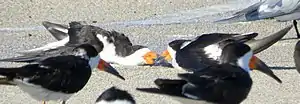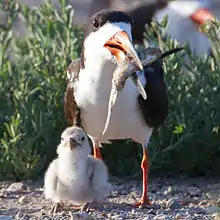Black skimmer
The black skimmer (Rynchops niger) is a tern-like seabird, one of three very similar birds species in the skimmer genus Rynchops in the gull family Laridae. It breeds in North and South America. Northern populations winter in the warmer waters of the Caribbean and the tropical and subtropical Pacific coasts, but the South American races make only shorter movements in response to annual floods which extend their feeding areas in the river shallows.
| Black skimmer | |
|---|---|
 | |
| Scientific classification | |
| Kingdom: | Animalia |
| Phylum: | Chordata |
| Class: | Aves |
| Order: | Charadriiformes |
| Family: | Laridae |
| Genus: | Rynchops |
| Species: | R. niger |
| Binomial name | |
| Rynchops niger | |
 | |
| Synonyms | |
|
Rynchops fulva Linnaeus, 1758 | |
Taxonomy
The black skimmer was described by the Swedish naturalist Carl Linnaeus in 1755 in the tenth edition of his Systema Naturae and given the binomial name Rynchops niger.[2] The genus name Rynchops is from the Ancient Greek rhunkhos "bill" and ops "face". The specific niger is the Latin word for "black".[3] The black skimmer is one of three species in the genus Rynchops.[4]
There are three subspecies:[4]
- R. n. niger (Linnaeus, 1758) – migratory, breeds on the Atlantic coast of North America, and from southern California to Ecuador in the Pacific
- R. n. cinerascens (von Spix, 1825) – is larger, has dusky underwings, only narrow white fringe to its black tail, and breeds in northern and northeastern South America and the Amazon basin
- R. n. intercedens (Saunders, 1895) – occurs on the rest of the Atlantic coast of South America south to central Argentina
Description
The black skimmer is the largest of the three skimmer species. It measures 40–50 cm (16–20 in) long with a 107–127 cm (42–50 in) wingspan.[5] This species ranges from 212 to 447 g (7.5 to 15.8 oz), with males averaging about 349 g (12.3 oz), as compared to the smaller females 254 g (9.0 oz).[6] The basal half of the bill is red, the rest mainly black, and the lower mandible is much-elongated. The eye has a dark brown iris and catlike vertical pupil, unique for a bird. The legs are red. The call is a barking kak-kak-kak.
Adults in breeding plumage have a black crown, nape and upper body. The forehead and underparts are white. The upper wings are black with white on the rear edge, and the tail and rump are dark grey with white edges. The underwing colour varies from white to dusky grey depending on region.
Non-breeding adults have paler and browner upperparts, and a white nape collar. Immature birds have brown upperparts with white feather tips and fringes. The underparts and forehead are white, and the underwings as the adult.
Behaviour and ecology


_in_flight.jpg.webp)
They spend much time loafing gregariously on sandbars in the rivers, coasts and lagoons they frequent.
Breeding
The black skimmer breeds in loose groups on sandbanks and sandy beaches in the Americas, the three to seven heavily dark-blotched buff or bluish eggs being incubated by both the male and female. The chicks leave the nest as soon as they hatch and lie inconspicuously in the nest depression or "scrape" where they are shaded from high temperatures by the parents. They may dig their own depressions in the sand at times. Parents feed the young almost exclusively during the day with almost no feeding occurring at night, due to the entire population of adults sometimes departing the colony to forage. Although the mandibles are of equal length at hatching, they rapidly become unequal during fledging.
Feeding
Skimmers have a light graceful flight, with steady beats of their long wings. They feed usually in large flocks, flying low over the water surface with the lower mandible skimming the water (in order of importance) for small fish, insects, crustaceans and molluscs[7] caught by touch by day or especially at night.
Development
 Chick and egg
Chick and egg Adult feeding a chick
Adult feeding a chick Juveniles at four weeks. They are distinguished from adults by the white speckled pattern on their wings and body.
Juveniles at four weeks. They are distinguished from adults by the white speckled pattern on their wings and body. Adult winter plumage
Adult winter plumage
Notes
- BirdLife International (2012). "Rynchops niger". IUCN Red List of Threatened Species. 2012. Retrieved 26 November 2013.CS1 maint: ref=harv (link)
- Linnaeus, Carl (1758). Systema Naturae per regna tria naturae, secundum classes, ordines, genera, species, cum characteribus, differentiis, synonymis, locis (in Latin). Volume 1 (10th ed.). Holmiae:Laurentii Salvii. p. 138.
- Jobling, James A. (2010). The Helm Dictionary of Scientific Bird Names. London: Christopher Helm. pp. 270, 344. ISBN 978-1-4081-2501-4.
- Gill, Frank; Donsker, David, eds. (2019). "Noddies, gulls, terns, auks". World Bird List Version 9.2. International Ornithologists' Union. Retrieved 24 June 2019.
- (2011).
- CRC Handbook of Avian Body Masses by John B. Dunning Jr. (Editor). CRC Press (1992), ISBN 978-0-8493-4258-5.
- Mariano-Jelicich, R; Favero, M.; Silva, M.P. (February 2003). "Fish Prey of the Black Skimmer Rynchops Niger at Mar Chiquita, Buenos Aires Province, Argentina" (PDF). Marine Ornithology. 31: 199–202. Retrieved 2009-06-29.
References
- ffrench, Richard (1991). A Guide to the Birds of Trinidad and Tobago (2nd ed.). Comstock Publishing. ISBN 0-8014-9792-2.
- Hilty, Steven L (2003). Birds of Venezuela. London: Christopher Helm. ISBN 0-7136-6418-5.
- A guide to the birds of Costa Rica by Stiles and Skutch ISBN 0-8014-9600-4
- Seabirds by Harrison, ISBN 978-0-7136-3510-2
External links
| Wikimedia Commons has media related to Black skimmer. |
| Wikispecies has information related to Rynchops niger. |
- "Black skimmer media". Internet Bird Collection.
- Field Guide on Flickr
- Stamps (for Antigua, Mexico, Nevis, Nicaragua, Uruguay) with Range Map at bird-stamps.org
- Black skimmer photo gallery at VIREO (Drexel University)
- Interactive range map of Rynchops niger at IUCN Red List maps
